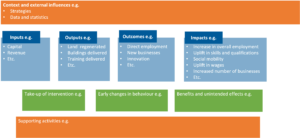How to develop strong Strategic and Economic Cases for Levelling Up Fund Round 3 Bids

How to prepare a robust strategic case for your bid application
In Levelling Up Fund Round 2, bids were required to:
Provide a theory of change – this lies at the heart of a successful bid.
A Round 3 bid will need a theory of change, which is a diagram showing how the inputs to the project will be converted into outputs, which enable outcomes, in turn generating impacts. It also shows how the context, external influences, and supporting activities could affect the success of the project.
Figure 1: Example of a theory of change diagram

Without a robust theory of change there is a risk that bid assessors will fail to be convinced the promised outputs and outcomes can be delivered.
Set out the case for investment
Round 3 bids will need an evidence base setting out the challenges and barriers to growth, using UK Government statistics and other robust sources of data. Bids must explain the market failures that are driving the need for public investment. Without a compelling case for investment there is a risk that bid assessors will rank bids below those able to demonstrate a stronger justification.
Show alignment with the local and national context
Bidders must show how the project helps to deliver local, regional, and national strategic aims. It must also complement and align with other planned investments. Without clear evidence of alignment, assessors may not understand how your project supports wider regeneration efforts in the local area, and give you credit for this.
Learn more about creating a business case >
How to demonstrate a compelling Economic Case
We mentioned in our previous post the likelihood of even greater emphasis on delivering value for money in LUF Round 3. Bids will need to be consistent with various Government documents, in particular the HM Treasury ‘Green Book‘ and project business case guidance. These are filled with technical terminology, often with complex definitions. We have highlighted a few key technical terms. Bidders for Levelling Up Fund Round 2 were asked to show:
How their ‘Benefit to Cost Ratio (BCR)‘ was calculated
The BCR is the ratio between the ‘present value’ of the benefits of the project and the ‘present value’ of the costs. A BCR greater than 1 indicates that the benefits outweigh the costs. A BCR of 2 or more is often sought by Government. This means the valued benefits need to be more than double the costs.
Examples of benefits are new employment, better employment (higher skilled and higher paid), more graduates, new businesses, and land value uplift. These need to be monetised, and the ‘net additional local impact’ calculated. Costs will include the capital and operational costs of the project, with ‘optimism bias’ added.
As well as the quantifiable costs and benefits, bids should describe and consider those which are much harder to measure e.g. awareness raising, improved perceptions, increased aspirations, and wider economic benefits.
The appropriateness of data sources and evidence used
Bidders will need to find and use robust data to make the case for your project. In the main, bids should rely on Government and ONS data, supplemented with any primary and locally specific data that is available.
Bids relying on unsubstantiated evidence and conjecture are less credible – assessors are unlikely to consider such information as part of their decision.
The effectiveness of the proposal in addressing the problems raised
Building on the ‘theory of change‘, bidders must set out how the proposed project will help to solve the problems, quantifying both the challenges and solutions as far as possible.
Having a clearly defined project that directly addresses the needs is critical for both preparing a compelling submission and being able to demonstrate robust deliverability. All too often projects are ill thought out, which causes substantial problems further down the line.
Learn more about making the case for economic development >
How to monitor and evaluate plans
Successful bids will be rigorously monitored and evaluated. They will need to provide information on inputs, activities, outcomes, and outputs. The approach to monitoring and evaluation will also need to be included. For Levelling Up Fund Round 2 funders wanted to see all baseline monitoring information prior to inception for successful bidders.
See how Hardisty Jones Associates can help you evaluate your Levelling Up Fund bid >

